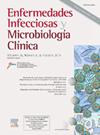干扰素γ释放试验中用于区分活动性结核和潜伏性结核感染的新抗原的鉴定
IF 2.5
4区 医学
Q3 INFECTIOUS DISEASES
Enfermedades infecciosas y microbiologia clinica
Pub Date : 2025-05-01
DOI:10.1016/j.eimc.2024.09.001
引用次数: 0
摘要
结核病(TB)仍然是一个重大的全球健康威胁,潜伏性结核病感染(LTBI)是结核病新发病例的主要来源。本研究旨在通过干扰素γ释放试验(IGRA)鉴定能够区分活动性结核(ATB)和LTBI的抗原。方法在文献回顾的基础上,选择4种LTBI候选抗原和2种ATB候选抗原。这些抗原经过基因合成、亚克隆、在细菌中表达和纯化。临床样本从诊断为ATB和LTBI的个体中收集,以帮助分析开发。然后利用这些抗原开发了新的IGRA检测方法,并评估了它们的鉴别效果。结果6种候选抗原中,只有3种(Rv2028c、Rv2029c和Rv0475)对LTBI具有潜在的鉴别潜力。特别是,在大肠杆菌中表达的Rv0475 (HBHA)没有甲基化,与ATB相比,在LTBI中表现出更大的刺激活性。单独来看,这些抗原的敏感性为72.4% ~ 93.3%,特异性为79.3% ~ 89.7%。多种抗原联合刺激可提高诊断的敏感性和特异性。结论三种LTBI抗原及其组合在鉴别ATB和LTBI中的潜在作用。将该抗原组合添加到传统的IGRA检测中,可以显著改善健康人、LTBI和ATB的临床分化。需要在更大、更多样化的患者群体中进行进一步的研究,以验证这些抗原组合在临床环境中的效用。本文章由计算机程序翻译,如有差异,请以英文原文为准。
Identification of novel antigens for distinguishing between active tuberculosis and latent tuberculosis infection in interferon-γ release assays
Introduction
Tuberculosis (TB) remains a significant global health threat, with latent tuberculosis infection (LTBI) serving as a major reservoir for new TB cases. This study aimed to identify antigens capable of distinguishing between active tuberculosis (ATB) and LTBI in interferon-γ release assays (IGRA).
Methods
Four candidate antigens for LTBI and two for ATB were selected based on a literature review. These antigens were synthesized genetically, subcloned, expressed in bacteria, and purified. Clinical samples were collected from individuals diagnosed with ATB and LTBI to aid in assay development. Novel IGRA assays were then developed using these antigens, and their discriminatory efficacy was assessed.
Results
Among the six candidate antigens tested, only three (Rv2028c, Rv2029c and Rv0475) showed promising discriminatory potential for LTBI. Particularly, Rv0475 (HBHA), expressed in Escherichia coli without methylation, exhibited greater stimulation activity in LTBI compared to ATB. Individually, these antigens demonstrated sensitivities ranging from 72.4% to 93.3% and specificities ranging from 79.3% to 89.7%. The combined stimulation of multiple antigens can improve the sensitivity and specificity of the diagnosis.
Conclusion
Our findings highlight the potential of three LTBI antigens and their combination in distinguishing between ATB and LTBI. Adding this antigen combination to the traditional IGRA assay could significantly improve the clinical differentiation of healthy individuals, LTBI, and ATB. Further investigation in larger and more diverse patient cohorts is warranted to validate the utility of these antigen combinations in clinical settings.
求助全文
通过发布文献求助,成功后即可免费获取论文全文。
去求助
来源期刊
CiteScore
2.10
自引率
8.00%
发文量
194
审稿时长
29 days
期刊介绍:
Hoy está universalmente reconocida la renovada y creciente importancia de la patología infecciosa: aparición de nuevos agentes patógenos, de cepas resistentes, de procesos con expresión clínica hasta ahora desconocida, de cuadros de una gran complejidad. Paralelamente, la Microbiología y la Infectología Clínicas han experimentado un gran desarrollo como respuesta al reto planteado por la actual patología infecciosa. Enfermedades Infecciosas y Microbiología Clínica es la Publicación Oficial de la Sociedad Española SEIMC. Cumple con la garantía científica de esta Sociedad, la doble función de difundir trabajos de investigación, tanto clínicos como microbiológicos, referidos a la patología infecciosa, y contribuye a la formación continuada de los interesados en aquella patología mediante artículos orientados a ese fin y elaborados por autores de la mayor calificación invitados por la revista.

 求助内容:
求助内容: 应助结果提醒方式:
应助结果提醒方式:


